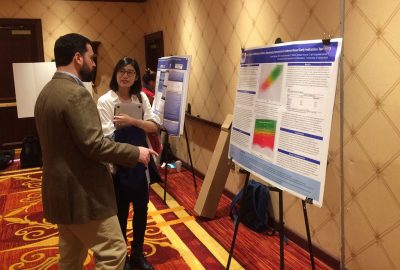Each year, more than half a million students drop out of high school in the United States.[1] But what if schools could predict which individuals were most at risk for dropping out — and perhaps even take action to prevent such an outcome? As it turns out, such a scenario is closer than ever to becoming a reality.
In more than 30 states across the nation[2] today, school districts are using what is known as an Early Warning System (EWS) to predict students’ academic milestones and specific student outcomes, including identifying those students who may be most likely to drop out. Connecticut is now on the cusp of joining them, thanks in part to the ongoing efforts of David Alexandro, a doctoral student in the Neag School’s measurement, evaluation, and assessment program, and his colleagues at the Connecticut State Department of Education (CSDE).
“State education departments, districts, and schools create early warning systems to improve student learning by addressing a range of outcomes,” says Alexandro, who is working with the CSDE to develop the state’s first EWS to help support Connecticut students in grades 1 through 12. “Within this framework, one of the most commonly studied outcomes is high school dropout. If a model can do a good job identifying potential dropouts early enough, then schools and districts can provide timelier, targeted supports and interventions to help more students graduate.”
“If a model can do a good job identifying potential dropouts early enough, then schools and districts can provide timelier, targeted supports and interventions to help more students graduate.”
— David Alexandro,
Ph.D. candidate, Neag School of Education
Connecticut’s Early Warning System
In Connecticut, the EWS under development — called the Early Indication Tool (EIT) — relies on data that public schools and districts across the state are already required to provide to the Connecticut State Department of Education. Using this data, Connecticut’s EIT, according to Alexandro, will be able to model the probability that, for instance, a student will drop out of school based on a combination of factors, including attendance, behavior, and course performance.
Alexandro, an intern in the CSDE’s Performance Office, joined the project this past May and is building on work started by fellow Neag School doctoral student William Estépar-Garcia. Estépar-Garcia spent about a year extracting data from several CSDE databases and developing a series of models that would predict student achievement for K-12 students.
“The EIT plays an essential role in supporting local education agencies in Connecticut’s Every Student Succeeds Act (ESSA) plan,” Alexandro says. “Working at the CSDE and building the EIT models has helped me to appreciate the potential of early warning systems in education.”
In fact, developing the EIT has since become the basis of his dissertation, in which he will go beyond traditional EWS approaches by evaluating machine-learning methods to predict student dropout risk and improve early warning systems.
While traditional EWSs typically designate each student as “on-track” or “at-risk,” the EIT will go a step further by identifying a targeted support level for every student. In addition, the EIT is unique in that it will provide a longitudinal view of student data for every student in a school or district — not only those students who are at risk or in need of targeted support.
“The launch of the Early Indication Tool is a huge milestone for education in Connecticut.”
— Ajit Gopalakrishnan,
Chief performance officer,
Connecticut State Department of Education
Now that the EIT’s models have been developed and tested at the state level, the tool, for students in grades 1 through 6, is being shared with districts statewide. Over recent months, Alexandro and his colleague Charles Martie, the CSDE education consultant who has been leading the state’s EWS development efforts, have been delivering presentations on the EIT to colleagues across Connecticut. In September, they presented the tool at the Performance Matters Forum, an interactive professional learning experience attended by more than 600 district and school leaders, data managers, and IT staff in Connecticut. In addition, through October and November, Alexandro and Martie presented the tool to education consultants, to CSDE leaders, at regional education research conferences, and during professional development sessions for principals, teachers, literacy coaches, and others.

“The Connecticut State Department of Education is thrilled to provide an ‘early warning system’ tool to all school districts,” says Ajit Gopalakrishnan, CSDE’s chief performance officer. “UConn interns William Estepar-Garcia and David Alexandro worked with Dr. Charles Martie at the CSDE to conduct the requisite research and modeling that have now enabled us to launch our Early Indication Tool. Will and David are highly skilled, competent, and thoughtful professionals who are passionate about the work and eager to make a contribution. The launch of the EIT is a huge milestone for education in Connecticut.”
Meaningful Research
Prior to joining the Neag School’s Ph.D. program, Alexandro had studied applied mathematics and engineering and, over the years, served as a management consultant; a programmer; a high school teacher; a volleyball, lacrosse, and basketball coach; and a high school administrator. It was his experiences in the realm of education that ultimately motivated Alexandro, a father of three, “to fully immerse [him]self in applied statistics and research, and work toward earning a Ph.D.”
The opportunity to work on the development and implementation of a successful EWS in Connecticut is one for which he is particularly grateful. “I am thrilled to have returned to my roots as a collaborative learner … while engaging in productive, interdisciplinary dialogue and meaningful research,” says Alexandro, who is working to complete his Ph.D. in May 2018.
“I would not be in a position to serve as an expert on this project without the training I received at the Neag School,” he adds, crediting Neag School faculty members Suzanne Wilson, Christopher Rhoads, Jane Rogers, Hariharan Swaminathan, and Eric Loken among his numerous mentors. “I bring a piece from each course I have taken in the measurement, evaluation, and assessment program to the EIT.”
EIT, which is currently being piloted in Connecticut, is scheduled to be fully implemented during the 2018-19 school year.
Access research reports, implementation guides, and more on Early Warning Systems compiled by the American Institutes for Research at earlywarningsystems.org.



